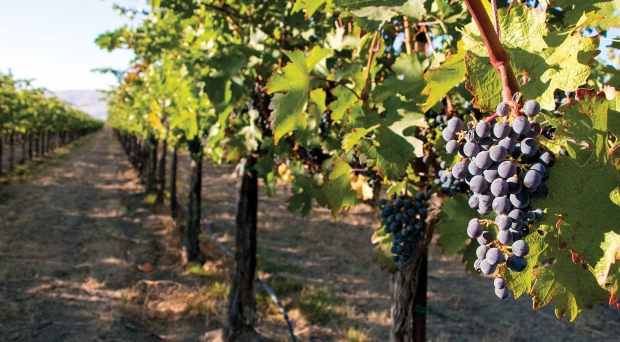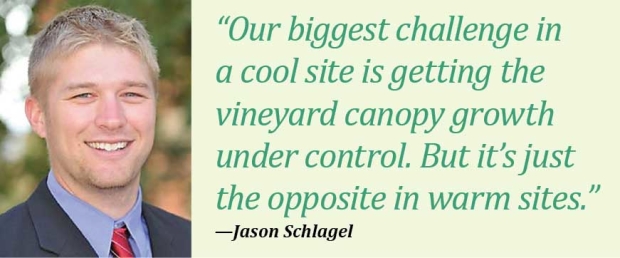
When growing Cabernet Sauvignon in cool sites, growers worry about fall rain and frost while waiting for grape flavors to fully develop. (TJ Mullinax/Good Fruit Grower)
Cabernet Sauvignon is one of the top two wine grape varieties produced in Washington State. But in some vintages the late-maturing grape can be a challenge to ripen properly in cool and warm sites.
Sometimes, a variety and site are perfectly matched, and the growing season is ideal, like Goldilocks’ porridge—not too hot and not too cold. But more often, growers must deal with an array of issues while striving to produce quality fruit.
Late-season Bordeaux varieties, like Cabernet Sauvignon, can be particularly challenging as growers wait for flavors to fully develop while worrying about fall rain and frost.
Two factors determine the relative warmth of a vineyard site: heat accumulation and length of the growing season.
Heat accumulation, expressed as degree-days, is measured by taking the average of the maximum and minimum daily Fahrenheit temperatures, subtracting 50 degrees, and then adding them together over an entire growing season.
 Wine grapes need at least 1,700 degree-days to adequately ripen, but if the climate is too hot, with more than 3,500 degree-days, fruit acidity and quality is reduced.
Wine grapes need at least 1,700 degree-days to adequately ripen, but if the climate is too hot, with more than 3,500 degree-days, fruit acidity and quality is reduced.
Generally, 2,700 to 3,000 and above are considered moderate to high heat units and 2,300 to 2,700 are considered low to moderate heat units. A growing season of 150 to 180 frost-free days is needed to ripen the fruit.
Jason Schlagel is not as concerned about a cool site’s potential for frost. He’s more interested in the length and quality of the ripening period provided by the cool site.
Schlagel is chief agriculture officer at Taggares Fruit Company and co-owner of the custom farming company Sierra Vista Farm Management, headquartered in Pasco, Washington. Taggares Fruit has extensive tree fruit and grape acreage in the Columbia Basin.
Schlagel has viticultural experience in both warm and cool sites. Before joining Taggares, he spent four years at Milbrandt Vineyards, a company with wine grapes in the warm Wahluke Slope and cool Ancient Lakes appellations and four years with Ste. Michelle Wine Estates, based in Paterson.
Canopy
“Our biggest challenge in a cool site is getting the vineyard canopy growth under control,” he said during a meeting of the Washington Association of Wine Grape Growers. “But it’s just the opposite in warm sites.”
Irrigation is a key tool he uses to manage canopy growth. Schlagel monitors the evapotranspiration (ET) rate in his vineyards daily. ET is the loss of water from the soil though evaporation and the plant’s transpiration. “ET numbers are generally lower in cooler sites than warmer ones,” he said. “We have a hard time with Bordeaux varieties, like Malbec, that have big berries, because in cool sites it’s difficult to achieve the small berry size that the winemakers want.”
He noted that last year, some of his cool site vineyards received only four to five inches of water per acre foot for the season. “We finally got control of the canopy in some blocks by August.”
On the flip side, the challenge presented by warm sites is growing enough canopy and providing enough irrigation without stressing vines too much.
Schlagel develops canopy and production targets in each vineyard, assigning target numbers to everything from pruning bud counts to shoot length to number of clusters. “We do everything we can to hit those targets,” he said.
In cool sites, he thins shoots more aggressively and generally has higher disease pressure compared to warm sites. Additional fungicide sprays are often needed in cool sites.
“Generally, in a warmer site, the winemaker wants excessive shoot thinning to develop thick skins on the berries and less methoxypyrazine, or green flavors,” he said.
When Cabernet Sauvignon is grown in a cool site, a winemaker may want herbaceous flavors, and purposely want more canopy shading, he explained.
But in both warm and cool sites, the timing of leaf removal is critical, says Schlagel. Leafing must be done early or fruit will sunburn.
In his own leafing trials conducted on Bordeaux red varieties, he found he could remove leaves on both sides of the canopy without sunburn problems, if leaf removal was done early.
While cooler sites can have higher disease pressure, warmer ones often require extra insecticide sprays due to additional pest generations. In some of his warm sites, he’s had three generations of leafhoppers to control.
Yield management
In both warm and cool sites, the secret to getting fruit ripe is yield management.
“Yield is absolutely critical to ensure you have quality and requires collecting a lot of data to get it right,” said Schlagel. In cooler sites, he constantly monitors cluster development. He also does more crop and color thinning in cool sites than warm ones. “If it’s a marginal site for Cabernet Sauvignon, and we’ve had uneven veraison, we will often do a quick color thin of the clusters.”
He believes flexible yield targets are advantageous for cool sites and can help the grower ensure quality. For years like 2010 and 2011, both very cool growing seasons, flexible yield targets for Cabernet Sauvignon can help ensure the crop ripens.
Schlagel also thinks that acreage contracts are important when growing late maturing varieties in cool sites.
“Acreage contracts are not as critical in warm sites,” he said. “Most of the time, you can get Cabernet Sauvignon ripe in a warm site—regardless of the vintage—if you do your cultural practices right.”
Lastly, labor is an issue when growing Bordeaux varieties in both warm and cool sites, particularly when viticultural practices must be done by hand. He noted that finding adequate labor in recent years has been an increasing problem for vineyardists. •






Leave A Comment